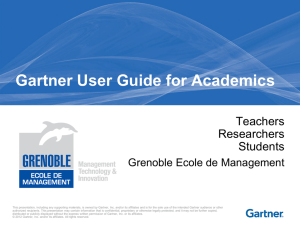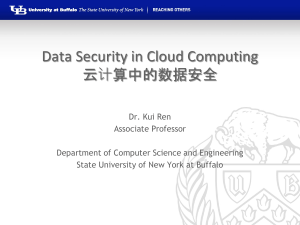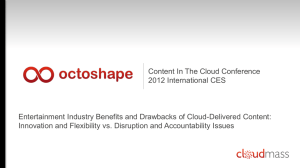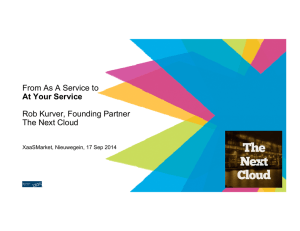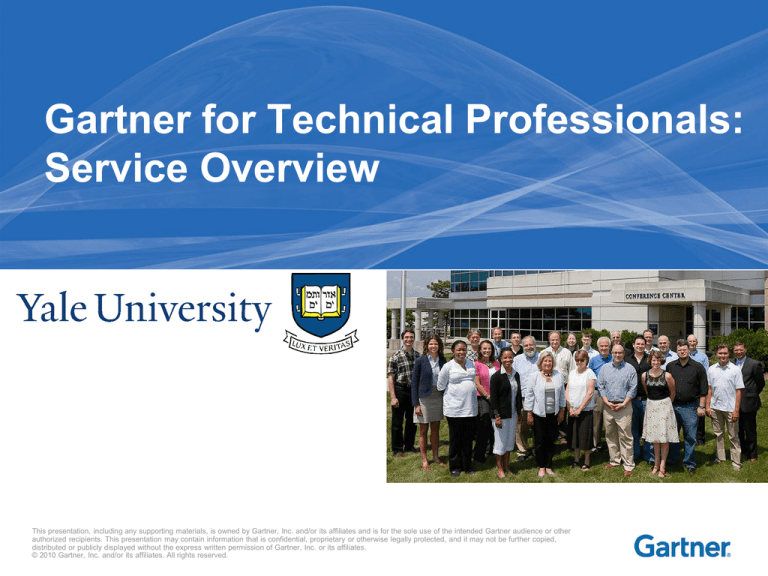
Gartner for Technical Professionals:
Service Overview
This presentation, including any supporting materials, is owned by Gartner, Inc. and/or its affiliates and is for the sole use of the intended Gartner audience or other
authorized recipients. This presentation may contain information that is confidential, proprietary or otherwise legally protected, and it may not be further copied,
distributed or publicly displayed without the express written permission of Gartner, Inc. or its affiliates.
© 2010 Gartner, Inc. and/or its affiliates. All rights reserved.
Leveraging your Gartner Resources
Name
How I can help
Campus Access:
Gartner for IT Leaders (GITL) Core Research
Published research focusing on strategic analysis of information technology trends,
vendors, products, and technologies. (Campus Access does not include access to or
participation in advisory discussion with the authoring analysts, called Analyst
Inquiries. It also does not include more actionable research content, such as Toolkits,
IT Key Metrics Data, and ITScore maturity assessments.)
Gartner for Technical Professionals (GTP)
Unlimited, independent access to Analyst Inquiries with authoring GTP analysts and to
research including Reference Architectures, Solution Paths, technical advisory content,
annual Planning Guides, etc.
Angela Garry
Account Executive
Responsible for the overall health and happiness of the Gartner and Yale partnership.
Helps to assess the needs and challenges of the organization and align the best set of
Gartner resources (research, advising, events, and consulting) to serve as the solution.
Angela.garry@gartner.com
617-574-5101
Craig White
Client Research Assistant, GTP
craig.white@gartner.com
801-307-5320
Steve Kaplan
Northeast Higher Education
Sr. Director of Consulting
Steven.kaplan@gartner.com
Yale’s dedicated resource for customized research recommendations and alignment of
Analyst Inquiries with the GTP service. Clients can call Craig to talk directly or send
an email with a high-level overview of your initiative, need or question, to receive
a customized research recommendation and suggested Analyst Inquiry.
Steve Kaplan has years of higher education consulting experience and is specifically
aligned to Yale to help determine the scope, purpose and goal of a given consulting
engagement. He aligns the best Gartner consulting experts based on the unique
scenario and oversees and leads the engagement to ensure success and satisfaction.
2
2013 Events Calendar
3
Gartner solutions are tailored to support the unique needs of
IT professionals at every level of your organization
Gartner Offering Focus
CIO
Senior IT
Leaders
Gartner for
IT Executives
Strategy
Gartner for
IT Leaders
IT Leader's
Extended
Team
Gartner for
IT Leaders —
Workgroup
Technical
Professionals
Gartner for
Technical
Professionals
Planning
4
Value Proposition
Equips CIOs with the role-specific
tools and knowledge they need to
deliver exceptional business results
for their organizations
Provides IT leaders with justin-time, role-specific insight from
Gartner analysts and peers to drive
outstanding results with their critical
initiatives and IT purchases
Management
Provides an IT leader's extended
team with the Gartner resources
they need to maximize the value
they deliver
Execution
Provides in-depth technical
research and guidance to help
technologists advance the
initiatives/projects that support
execution of the IT strategy
Different IT stakeholders have common goals, but different questions
Initiative
Cloud Computing
Question
CIO
IT Leader
(and Team)
Technical
Professionals
Targeted Research
What is the most
effective way to deliver
IT services across the
business?
Gartner for IT Executives:
"Optimizing IT Assets: Is Cloud
Computing the Answer?"
What is the maturity of
cloud computing
technologies, and what
impact do they have on
my road map?
Gartner for IT Leaders:
"Hype Cycle for Cloud
Computing"
How does the internal
cloud impact my
storage infrastructure?
Gartner for Technical
Professionals:
“Architecting Storage for the
Internal Cloud: One Step at a
Time"
5
Gartner for Technical Professionals delivers comprehensive
insight across the following areas
Roles
Key Functions
Security & Risk
Management
Security & Risk
Management
•
•
•
•
Identity & Privacy
• Identity creation and management
• Identity verification and use
• Privacy
Data Center
Infrastructure &
Operations
Network & Telecom
Business Intelligence &
Information Management
Applications
Data Management
Collaboration & Content
Management
Application Platform
Cloud
Topics
6
Mobility
Application and data security
Cloud security
Mobile security
Perimeter and infrastructure security
•
•
•
•
•
•
•
•
•
Computing hardware
Cloud and virtualization
Physical data center
Storage
Mobile device management
Network performance optimization
Real-time and unified communications
WANs and LANs
Wireless and mobility
•
•
•
•
•
•
•
•
Big data
Business intelligence
Data management
Database management
Collaboration and social initiatives
Communication, email, IM
Content management
SharePoint and portals
•
•
•
•
•
Application overhaul
Applications in the cloud
Mobile applications
Software development
SOA and integration strategies
Your teams get the knowledge and best practices to advance the
initiatives and projects that support your IT strategy
Guidance for each phase
of your project life cycle
In-depth research
Phase
• Reports typically 25 to 40
pages in length
• How-to frameworks and
best practices
• Unbiased vendor
recommendations
• In-the-trenches perspectives
(field research)
• Reusable
templates/graphics for your
internal documentation
Research Deliverable
Create a technical plan
Planning Guides
Evaluate and select a
technology
Technology
Assessments
Develop the technology
architecture
Reference Architecture
Select the right
products
Product Assessments
Create an
implementation
strategy
Guidance Framework,
Field Research
7
Reference Architecture: A proven decision-making tool that
provides tailored architecture recommendations
Architecture guidance from three key perspectives:
Principles define your core IT
values to accelerate planning
and decision making
Foundation
Decision Points tailored
designs based on typical
requirements and GTP expert
guidance
then
if
otherwise
Templates reusable graphics
showing the critical relationships
between technical capabilities
8
SaaS Email Solution Path
Provides the steps required to answer a complex question
9
Through 60-minute analyst calls, our world-class experts become
your objective architecture advisors
Analyst facts
• 50+ analyst experts
• Average of 23 years' industry
experience
• Collectively: 32 books, 37 patents
• Deep technical expertise in
architecture and deployment
challenges
Meet some of our analysts
Richard Watson
• 19 years in the IT industry
• Previously application architect
at Credit Suisse
Larry Cannell
• 27 years in the IT industry
• Previously workstream lead for
collaboration and business
intelligence for Ford Motor Co.
Mark Diodati
• 22 years in the IT industry
• Previously Technical Architecture
Principal at RSA
How our analysts help you
• Evaluate and get up to speed quickly
on new technologies
• Learn about best practices your peers
have used to implement a technology
• Validate and get feedback on your
technical strategy, architecture and
project plans
Marcus Collins
• 29 years in the IT industry
• Previously data architect at
Novartis
Ramon Krikken
• 17 years in the IT industry
• Previously security architecture
manager at TD Bank
10
Projects we help with
• Application and Database Security • Directory Services
• Audit and Compliance
• Federation
• Authentication
• Host and Endpoint Protection
• Authorization and Entitlement
Mgmt.
• Identity as a Service
• Business intelligence
• Collaboration
• Communication
• Content Management
• Content Security
• Data Access Strategies
• Data Center Computing
• Data Center Operations and Mgmt
• Data Center Storage
• Data management
• Database Mgmt
• Security Concepts, Techniques, and
Approaches
• Server Virtualization
• Service Oriented Identity
• Site and Data Center
• Managing IT
• Network Operations and
Performance Mgmt
• Perimeter and Infrastructure
Security
• Platforms, Languages, and
Frameworks
• SOA and Integration Strategies
• Software Development Lifecycle
Strategies
• Technologies and standards
• Unified Communications
• Presentation Strategies
• WANs and Provider Network
Services
• Privacy
• Wireless and Mobility
• Provisioning and Identity Mgmt
• Relationships
• Risk Management and Compliance
• Roles
11
Gartner for Technical Professionals provides in-depth technical
research to help your teams deliver outstanding results
Benefit
Accelerate
project timelines
Mitigate risk
Develop your
skills
How
• Get teams up to speed quickly through access to in-depth
research
• Use proven Reference Architecture to develop technology
architecture
• Receive organization-specific guidance through calls with
analysts*
• Leverage industry best practices to avoid costly mistakes
• Avoid vendor lock-in through unbiased recommendations
• Validate and get feedback on project plans through speaking
with analysts*
• Update knowledge and skills through exposure to in-depth
technical research
• Help them acquire deep expertise on a broad range of
topics
• Enable them to stay current with changing markets and
technologies
*Available to Advisor-level clients.
12
Appendix
Coverage Details by Function
13
Application Platform Research
Audience: Application delivery organization (architects, managers, project
leaders and developers)
Major issues
Key coverage areas
• Projects are late, over
budget or not what was
wanted
• Improving the software development process
• Application portfolio is
bloated, inflexible and
expensive
• New demands: mobile,
social, contextual and
cloud computing
• Mobile and social computing
• Improving the user experience
• Application architecture (e.g., SOA, WOA, EDA,
cloud)
• Application portfolio modernization
(including cloud migration)
• Application platform modernization
(including hybrid cloud)
Analysts: Anne Manes, Richard Watson, Sean Kenefick, Kirk Knoernschild,
Danny Brian, Eric Knipp
14
Collaboration and Content Management Research
Audience: Communication, collaboration and content management architects,
managers and project leaders
Major issues
Key coverage areas
• Improving the
productivity of
information workers
• Communication (e.g., email, IM, Web
conferencing, unified communications, VoIP)
• When to use the new
delivery models:
virtualization and SaaS
• Social software (e.g., social networking, blogs,
wikis)
• Business demands for
increased mobile and
social software support
• Collaboration (e.g., workspaces, SharePoint)
• Content (e.g., document management, Web
content management, search, taxonomies, text
analytics)
• 3C SaaS solutions (e.g., Google Apps, Microsoft
365)
Analysts: Craig Roth, Guy Creese, Larry Cannell, Bill Pray, Ken Agress, Mark
Cortner, Darin Stewart, Elden Nelson
15
Data Center Research
Audience: IT infrastructure organization (data center architects, virtualization/
storage/compute IT staff, enterprise IT professionals, directors and VPs of IT)
Major issues
Key coverage areas
• Data center power and space at
a premium
• Server/client virtualization, internal cloud
computing, hybrid clouds
• Virtualization, storage reduction
and server economization efforts
changing the face of the
data center
• Storage virtualization, platforms,
deduplication, data protection, backup,
archive, cloud storage
• These efforts are enough to stem
the tide of data center growth —
thus, IT organizations are
building internal and hybrid
clouds
• Server platforms, HA, DR, OSes,
facilities, operations
• Data center networking, IPv6,
switches, cabling
Analysts: Drue Reeves, Richard Jones, Alessandro Perilli, Chris Wolf, Kyle
Hilgendorf, Matt Brisse, Nik Simpson, Werner Zurcher, Simon Richard, Gunner
Berger (VDI)
16
Data Management Research
Audience: Data management organization (data architects, information
managers and enterprise IT professionals)
Major issues
Key coverage areas
• Data is replicated,
overproduced and
undermanaged
• Master data management, data warehousing,
business intelligence, information life cycle
management, information governance
• Databases are neither
quantified nor qualified
• Big data goes beyond the capacity of traditional
database technology
• Available information is
underutilized by
business people
• Real-time data tells how things are instead of how
things were
• Shared data is accessible beyond the silo(s) that
created it
• High-fidelity data preserves the context, detail,
relationships and identities of important business
information
Analysts: Marcus Collins, Lyn Robison, Svetlana Sicular, Jamie Popkin
17
Identity and Privacy Research
Audience: Identity management organization, privacy organization (architects,
project leaders, developers, privacy officers and data stewards)
Major issues
Key coverage areas
• Projects are late, over budget or not what
was wanted
• Identity and access
management program
• Creating, managing and using identities
are expensive
• Creating and managing
identities
• IdM systems don’t handle partner,
contractor and customer identities well
• Verifying and using identities
• Privacy program
• Security and privacy regulations are
complex and rapidly changing
• Mobile, social, contextual and cloud
computing; federation, data protection
Analysts: Ian Glazer, Lori Robinson, Robin Wilton, Trent Henry (SSO), Heidi
Wachs, Nick Nikols, Mary Ruddy (Federation)
18
Network and Telecom / Wireless and Mobility Research
Audience: Networking, end user computing and security organization (architects,
administrators and network management staff)
Major issues
Key coverage areas
• Securing and managing
mobile endpoints
• Wireless technology — 802.11, 3G/4G, NFC,
Bluetooth, TV white space
• Providing adequate
wireless service levels
• Mobile services — voice/data, location, SMS,
Mobile UC, Wi-Fi/cellular roaming
• Mobile management — MDM (tools, services,
vendors), WLAN management
• Enterprise mobility strategy — endpoint
independence methodology
• Security — wireless LAN security
• Application performance optimization — WANs,
mobile networks
Analysts: Paul DeBeasi, Mike Disabato, Jim Berenbaum, Eric Siegel, Richard Jones,
19
Security and Risk Management Research
Audience: Security and risk management organization (architects, administrators
and risk management staff)
Major issues
Key coverage areas
• Information security risk
from outsiders (hackers,
thieves, etc.)
• IT risk management
• Information security risk
from insiders
• New demands from
business: mobility, cloud
computing, social media
• Application, data, endpoint and network security
• Information security program management
• Compliance
• Threat and vulnerability management
Analysts: Anton Chuvakin, Mario de Boer, Ramon Krikken, Phil Schacter, Eric
Maiwald, Erik Heidt (GRC), Ben Tomhave
20
Cloud Computing Research
Audience: IT organization in general; procurement and legal
Cloud computing touches every part of the IT organization, including infrastructure,
application development, security, applications and data
Major issues
Key coverage areas
• Driven by desire to cut
capital cost to host
applications and data in
internal data centers and
increase IT agility
• SaaS, infrastructure as a service (IaaS),
platform as a service (PaaS)
• Cloud computing has
issues in security, liability,
reliability, compliance,
performance, market
immaturity and other
areas
• Internal/private clouds, hybrid clouds, public
cloud provider evaluation, cloud brokers
• Cloud strategy, cloud security and risk
management, cloud storage, cloud application
development/optimization, SaaS email
• IT risk management and compliance
• Application, data, endpoint and network security
• Information security program management
• Threat and vulnerability management
Analysts: Drue Reeves,
Kyle Hilgendorf (public cloud), Richard Watson, Anne Manes, Alessandro Perilli
(private cloud), Chris Wolf, Trent Henry, Guy Creese, Matt Brisse, Richard Jones
21
Professional Effectiveness Research
Audience: IT practitioners and IT managers in all organizations (applicable to
various technical domain backgrounds)
Major issues
Key coverage areas
• Understanding the business
context of technical
decisions
• The drivers that influence business
technology adoption and application
• Improving business-relevant
communication and
influencing skills
• Improving cross-discipline
decision making and
outcomes
• Practitioner career planning
and expectations
• Engaging common, cross-functional initiatives
effectively
• Developing the IT professional to become a
leader
• Improving cross-competency maturity,
decision making and outcomes
• Effects of human behavior and social change
on organizational and individual performance
Analysts: Jack Santos, Mike Rollings
22



